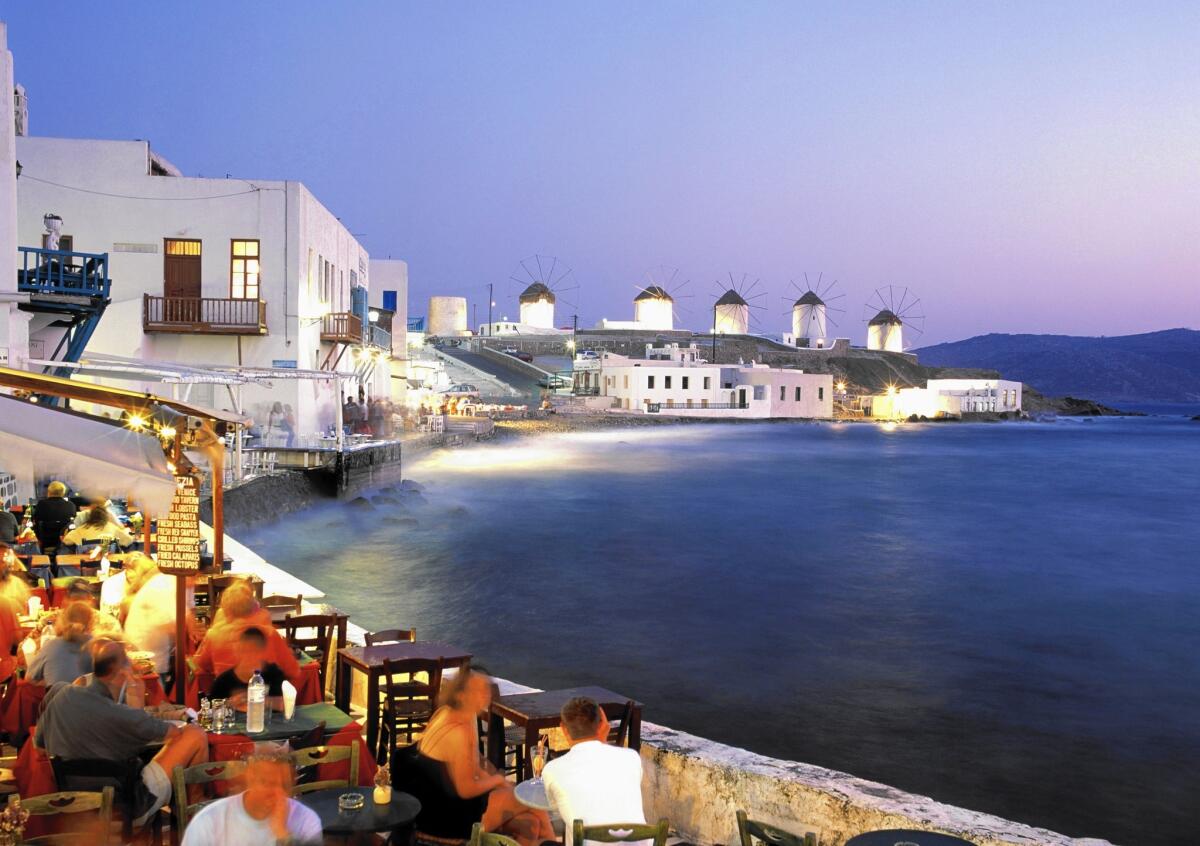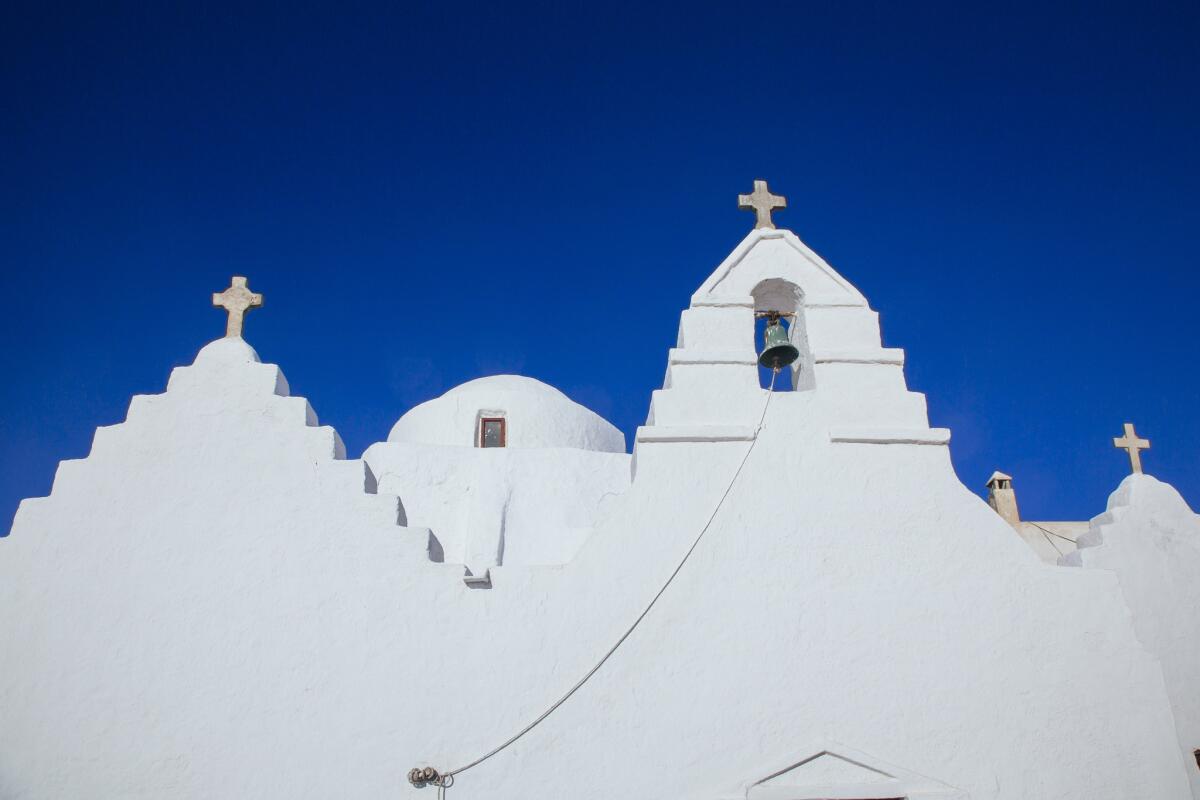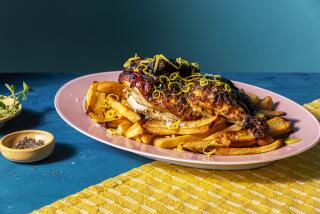Under the spell — again — of Mykonos, Greece

- Share via
MYKONOS, Greece — On my first visit to Mykonos, I swarmed the island with one friend and a few hundred strangers, fellow travelers on an inexpensive cruise in the Aegean Sea. I’d scheduled the four-day voyage in the middle of a post-college trip to Europe, and I prepared by packing cute shoes, nail polish, a carton of cigarettes, a bikini, a dry-clean-only party dress and a pair of brown Chemin de Fer jeans.
Our time at sea was a respite from the cheap hotels and youth hostels that supplied most of our accommodations. True to form, before we disembarked to explore the town of Mykonos, we gorged on the breakfast buffet. Afterward, we walked around for several hours, oblivious to the July heat.

Traditional buildings on Mykonos street, Cyclades Islands, Greece.
Our full stomachs allowed us to forgo spending precious cash on food and to splurge on ceramic tiles, beer and grappa, which we downed in shots on a dare from various locals who seemed to find us amusing.
It never occurred to us to read up on our port of call. With our first glimpse of the whitewashed buildings set against the bluest of skies, we just assumed that Mykonos would be outstanding.
And it was.
Before my return visit in October, I prepared by reading travel articles and guides and consulting with friends who had visited Mykonos in recent years. I researched hotels and restaurants, and I read up on the sugar content of likely-to-encounter liqueurs. (Hangovers are harder to shake than they used to be.)
I packed easy-to-wash hiking pants made from some terrifying manmade material, hiking boots (sadly, I could not find them with kitten heels), sunscreen and a one-piece.
A few changes
I’d made a few changes in the intervening years, acquiring 15 pounds, a 31-year marriage to a man named Steve and two grown children (who were not invited on the trip).
But some things do not change: The landscape in Mykonos was just as mesmerizing as it had been the first time. The white of the buildings was still blinding; the blue of the sky still piercing.
There were no 3 a.m. toasts to the gods of fortune in a ship’s nightclub, but an early-morning walk through quiet streets was equally rewarding, especially a solo encounter with a large pink pelican that assumed I was placed on this earth to placate him with food.
Walking the streets and back alleys for two days was not an exercise in nostalgia; it was an opportunity to experience a different version of Mykonos, one equally as beautiful but with a narrative dominated by the stories of shopkeepers, waiters and boat captains. This time I listened.

Paraportiani church, Mykonos, Cyclades, Greece.
We arrived midday after a brief flight from Athens and took at 12-minute cab ride to the Hotel Belvedere in the little town of Mykonos, which is also known as Chora (which means “town” in Greek). We wandered for a couple of hours, looking at the Church of Panagia Paraportiani (Our Lady of the Side Gate), the Little Venice neighborhood and the windmills (one of the signature sights on the island) that overlook the harbor of Alefkandra.
But at some point, our need for food overwhelmed our desire to explore. We agreed to eat at the next restaurant we encountered, which turned out to be a tiny waterfront café called Sunset that was rapidly filling with visitors pouring off a cruise ship.
At first we regretted our choice, but the view of the harbor and the sound of the sea were palliative; the mounds of arugula, tomatoes, cucumbers, olives and feta, filling.
Our waiter winked at us and rolled his eyes in mock despair as he threaded his way through customers and potential customers, making us feel as though we were part of some exclusive club.
It’s a lunch that is undoubtedly served hundreds of times each day in the small town, and we ordered something similar the next day at a tiny place called Caesar’s, where we were the only customers. But the tomatoes were flavorful and the cheese was sharp and fresh, and we ordered spanakopita in hopes of tasting more feta.
The proprietor was happy to chat and told us we’d arrived on the last day of the season; she was about to shutter the restaurant and return to Athens until spring. Many other businesses, she told us, had already closed.
But not all of them.
Foodie tourists
After some consultation with the hotel clerk, we decided to have our first dinner at a restaurant called M-eating, a place where the wait staff worked hard to answer all our foodie tourist questions: What were the ingredients in the sauce that was served with a chunk of grilled octopus? Did the chef sous-vide the pork in the caramelized pancetta and pork neck duet?
Our waiter queried the kitchen two or three times with our questions — or at least he said he did — and we happily took notes because each dish was better than the last. It seemed as if everyone — waiters, busboys and, later, potential diners reading the menu posted outside the entrance — traded questions and anecdotes that night.
Join the conversation on Facebook >>
Was there anyone on Mykonos who was not eager to engage? If so, we didn’t encounter them. A clerk in a tiny souvenir shop said she’d moved to Mykonos from Serbia six years ago, when she was 21. She smirked at the notion of leaving for the winter; her 6-year-old daughter goes to a local school, so she works wherever she can in the off-season. And by the way, she added, the Serbs on the island do all the work when those with the means to leave depart for the mainland.
Not so, said a man behind the counter of a jewelry shop. His son and daughter are fifth-generation Mykonians, and the family lives there year-round. Mykonos, he continued, attracts workers from “all over”: Poland, Macedonia, Bulgaria.
Who knows what the truth is? Our job was simply to take it all in.
Which is how I learned a little bit about Petros, the three-foot-high pelican that started to stalk me one morning as I walked to the harbor. I felt a little sheepish as I peered over my shoulder to monitor his progress — Was he getting closer? Were pelicans aggressive? — but a woman weighted down with groceries stopped to assure me that he was a fixture at the town harbor, the third or fourth Petros to waddle the streets in the last several decades and an unofficial mascot, inspiring countless online tributes.
Later in the day, I spotted him preening in front of several dozen visitors who cooed at his every move and indulged his need for attention and calories. Would I have fallen under the spell of a large water bird during my first visit? Probably not.
Simply present
My thoughts on accommodations had evolved as well. On my first visit, I slept in a tiny stateroom with two other people; on the second, I booked a room at the Belvedere, a small boutique-y hotel on a hill overlooking the Aegean and a 10-minute walk to the town center.
Our room was equipped with a balcony, a perfect view of the sea and all the accouterments (flat-screen TV, tasteful white décor with wooden accents and lots of towels) that American tourists undoubtedly hope for when they leave the U.S. The Matsuhisa restaurant was closed for the season, but the breakfast buffet offered a wealth of choices that included five or six types of yogurt. We tried them all.
This — yogurt and pelicans, flat screens and churches, recipes and jewelry — is what happens when you wait 38 years to return to Mykonos. We did not go clubbing, nor did we race around the island on all-terrain vehicles. We did not perfect our tans. We were, simply, present, and it wasn’t a bad way to be.
::
If you go
THE BEST WAY TO MYKONOS, GREECE
From LAX, Air France, Lufthansa, British, American, Delta, Swiss and Virgin Atlantic offer connecting service (change of planes) to Mykonos. Restricted round-trip fares from $983 to $1,552
WHERE TO STAY
Hotel Belvedere, School of Fine Arts District, 011-30-2289-025122, www.belvederehotel.com
WHERE TO EAT
M-eating, 10 Kalogera St., 011-30-2289-078550, www.m-eating.gr/eng/
Caesar’s, Goumenio Square, 011-30-2289-027004, www.caesarsmykonos.gr
Sunset Taverna, 011-30-2289-027948
TO LEARN MORE
Greek National Tourism Organization, www.visitgreece.gr
Municipality of Mykonos, www.mykonos.gr/?PageLang=english
More to Read
Sign up for The Wild
We’ll help you find the best places to hike, bike and run, as well as the perfect silent spots for meditation and yoga.
You may occasionally receive promotional content from the Los Angeles Times.







